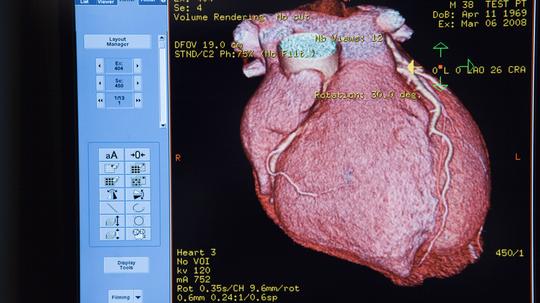
Ventricular tachycardia (VT) is a common, potentially life-threatening heart arrhythmia that occurs in the organ’s lower chambers in patients with heart disease or heart failure, which can lead to sudden cardiac death. While there are a variety of treatments, not all of them work for people suffering from the disorder.
One of the most common treatments, a cardiac catheter ablation, can fail nearly half of the time in preventing further episodes of VT. Medication is another option, but sometimes patients find the side effects too difficult to live with.
There’s newfound hope for these patients at Allegheny Health Network (AHN) in Pittsburgh. That’s where a multi-disciplinary team of physicians is involved in a clinical trial of a novel, non-invasive radiation treatment helping patients with difficult heart anatomy who have run out of other treatment options. So far, five patients have successfully been treated there with stereotactic arrhythmia radioablation (STAR). It’s a procedure that, after obtaining a 3D map of the heart from the initial catheter procedure, takes 15 minutes to perform.
“All of those patients would have died without this treatment,” said Dr. Mark Trombetta. “This allowed one patient who was experiencing so much nerve pain because of the toxicity of his medication to get off that medication and live a normal life.”
Trombetta is system director of clinical programs – Division of Radiation Oncology at the Allegheny Health Network Cancer Institute. He’s working in the clinical trial with a team that includes Dr. Emerson Liu, director of electrophysiology research and innovation at Allegheny Health Network, and Dr. Seungjong Oh, a medical physicist at the health system.
How stereotactic arrhythmia radioablation works
The cardiac catheter ablation is an invasive procedure that involves inserting a tube into a patient’s heart to destroy small areas of tissue that may be causing the abnormal heartbeat. This method often fails because scar tissue or thick areas of the heart muscle prevent the effective application of energy to cauterize all of the necessary areas. But since it’s a first line of treatment, even if it fails it does provide a 3D map that can be used for this new procedure.
Radiation has long been used to treat cancer patients, but its application to VT is fairly new, dating to 2012 at Stanford University.
The non-invasive STAR procedure has the unique advantage of delivering ablative energy to any desired volume within the heart to reach sites that are inaccessible with catheter ablation, the Arrhythmia & Electrophysiology Review reports. Small studies of STAR in patients with refractory VT have provided promising efficacy and safety data.
Liu said the technique allows doctors to gain access to areas of the organ they can’t reach with catheters and more directly target the primary tissue for a patient’s unstable heart rhythms with radiation beams. In the future, the goal is to figure out a way to find those target areas accurately in a non-invasive manner.
“We are in a technologically driven field, which is allowing us to have access to different areas of the heart,” Liu said. “This is a continuation of the trend of technology allowing us to do procedures less invasively, more quickly and more efficiently. In this scenario, a patient isn’t again lying on an operating table for six hours with a catheter inserted into his groin.”
In an early analysis of STAR, published as a preprint in medRxiv, researchers looked at the effectiveness and safety of STAR for VT therapy in 39 patients across four observational studies. It was concluded that VT burden reduction at six months was close to 91% and the need for anti-arrhythmia drugs declined by more than 80% within the same time frame.
Physicians thinking past the traditional limits of medicine
Under Liu’s and Trombetta’s direction, AGH is serving as the country’s primary investigative lead site on a global Elekta MR-Linac Consortium initiative, further assessing the efficacy of STAR for VT. It’s estimated that approximately 150 patients worldwide have been treated with STAR.
Trombetta said the goal is to establish this therapy through a broader experience as an innovation that will ultimately result in better long-term outcomes, lower hospitalization rates and improved quality of life for patients.
“Working in a multi-disciplinary team in a collaborative nature to help people desperate for care is really humbling from a professional standpoint,” Trombetta said. “We’re able to come together and combine different specialties to treat patients who, prior to this innovation, had run out of options.” Oh, who developed special computer software to increase the precision of the radiation targeting, said he could not sleep prior to the first patient’s treatment knowing his work might change someone’s life so dramatically.
Liu said the patients who go through the new procedure have already spent a lot of time dealing with the disorder through ongoing doctors’ visits and prior procedures.
“At that point, they are like family. You are invested in them, and they trust you,” Liu said. “It really brings them hope because after all they’ve been through, it’s a good feeling to know you don’t have to give up on taking care of them because you’ve otherwise run out of options. This is physicians thinking outside of the box when traditional therapies fail, so you can continue care past the traditional limits of medicine.”
To schedule an appointment with an AHN specialist, call 412-DOCTORS.
Allegheny Health Network, a Highmark Health Company, is a western Pennsylvania-based integrated healthcare system that serves patients from across a five-state region that includes western Pennsylvania and the adjacent regions of Ohio, West Virginia, Maryland and New York.
Laura Newpoff is a freelance writer with The Business Journals Content Studio.
